Google Workspace cheat sheet: What is it, and how does it work?
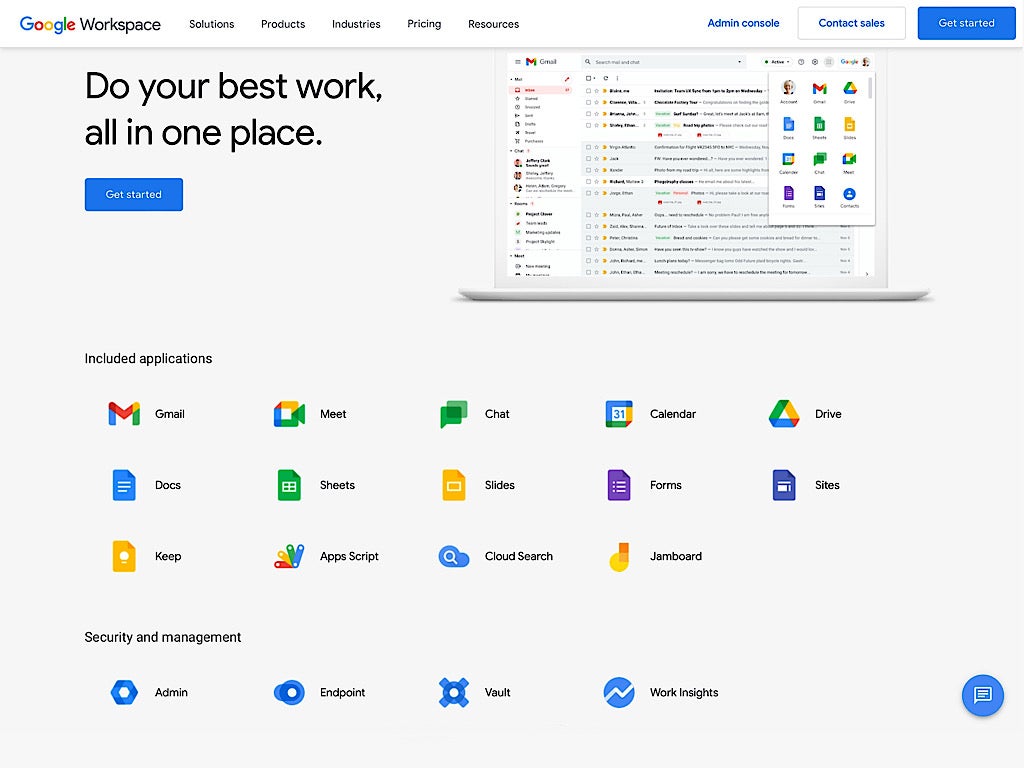 Image: Google
Image: Google
Google Workspace is a set of communication and collaboration apps built for people in organizations. The core Google Workspace communication apps, such as Gmail and Google Meet, are widely used around the world, as are the collaboration apps, such as Google Docs, Sheets, Slides and Forms. The collaboration apps have been built from the beginning to allow multiple people to edit a document, spreadsheet or presentation simultaneously.
Jump to:
What is Google Workspace?Google Workspace accounts are created and managed by an administrator, in contrast to the standard free Gmail or Google accounts that an individual may create. The administrator has considerable control over Google Workspace defaults, app access and security settings. Workspace allows different configurations to be applied to different groups of people — or, in Workspace terms, different organizational units.
Google Workspace can be configured to serve organizations that deal with highly sensitive data as well. For example, an administrator may prevent offline storage of Workspace data, such as email, calendar items and Drive files.
SEE: Use this cloud engineer hiring kit from TechRepublic Premium to find the right person to manage your cloud setup.
What apps are part of Google Workspace?The following apps are available as part of the core offering for most editions of Google Workspace. For more details about each app, click the link name to go to the corresponding Google Workspace page.
One important aspect of Workspace apps is speed. Google offers .new shortcuts, which, when entered in a modern browser’s URL box, create a new item of the type indicated. For example, cal.new creates a new Google Calendar event, while doc.new creates a new Google Doc.
The following offerings are not prominently featured as core Workspace apps but are often available, depending on the edition of Google Workspace you use. In some cases, these require additional purchases.
SEE: Discover tips and tricks on how to use Google Meet with this free PDF from TechRepublic.
What do I need to access Google Workspace? A modern browser (Chrome strongly recommended)On desktop platforms, such as Windows and macOS, Google Workspace apps may be accessed with a modern web browser. In most cases, organizations that use Workspace will also want to standardize on the Google Chrome browser. Signing in to your Workspace account with the Chrome browser not only gives you access to Workspace apps but also lets you leverage some Chrome-only features.
For example, if an administrator allows it, people may configure Gmail, Docs, Sheets and Slides to sync locally for offline work. Many other modern browsers, such as Microsoft Edge, Firefox Browser and Safari, let people use most Google Workspace app features while online.
SEE: Become a Google Docs power user with this free PDF from TechRepublic.
Google Drive for desktopFor Windows and macOS systems, Google offers Google Drive for Desktop (formerly Google Drive File Stream), which lets people browse Drive files and folders with a locally installed app. This makes the experience of navigating items stored on Drive much like navigating the local file system.
Cloud: Must-read coverage Android, iOS and iPadOS appsSeveral Google Workspace apps are available to be installed on Android, iOS and iPadOS systems. For example, Gmail, Calendar, Drive, Docs, Sheets, Slides, Meet, Chat and Keep may be downloaded and installed either from Google Play (Android) or the iOS App Store (Apple).
Note: Currently, no mobile apps exist for either Google Sites or Google Forms; although, websites or forms created by those apps do work well on mobile devices.
SEE: Compare iCloud and OneDrive to see which is best for Mac, iPad and iPhone users.
Optional: Hardware and Chrome EnterpriseMany organizations that use Google Workspace choose to purchase related items, such as Chromebooks, Google Meet hardware, Jamboard devices or Google Voice phone equipment. These devices and their related services may be connected to your organization’s Workspace account to be configured by a Workspace administrator.
Chromebooks and other Chrome OS devices in various formats, such as tablets or 2-in-1s, allow people to sign in with a Google Workspace account, then gain full access to all Workspace apps. Most modern Chromebooks can run Android apps, many run Linux apps and a few higher-end devices run Windows apps with the aid of third-party software. Chrome Enterprise controls lets an administrator fully manage and deploy Chrome and Chrome devices.
SEE: Explore all of TechRepublic’s cheat sheets and smart person’s guides.
What editions of Google Workspace are available?Google differentiates Workspace editions by number of accounts, customer organization type and capabilities.
First, the Business editions are only available for organizations that need up to 300 user accounts. Organizations that need more than 300 accounts should contact Google to explore Enterprise editions. If you want Workspace for a single user, you might consider Google Workspace Individual, but you could select any Business or Enterprise edition.
Second, some editions are only available to specific types of organizations, such as nonprofit and educational organizations.
Third, storage limits, Meet limits on participant numbers and recording, management capabilities for security configuration and reports, and access to certain apps tend to increase as you move from Starter to Standard to Plus editions.
SEE: Compare Zoom versus Microsoft Teams, Google Meet, Cisco WebEx and Skype to find the right video-conferencing apps for you.
Pricing varies, based on both your organization and the Google Workspace edition. For example, educational institutions and nonprofit organizations may qualify to use some editions of Workspace for free, although these organizations may choose to upgrade to paid versions for enhanced capabilities and controls.
Below is a list of the editions offered; for more detailed pricing information, check out Google’s pricing page. Beyond the editions listed, Google promotes Google Workspace for Government, Google Workspace for healthcare and Google Workspace for retail businesses.
Google Workspace IndividualPriced at $9.99 per month, or $99.96 when paid annually, Google’s Individual edition includes booking services and email marketing, along with access to the core Workspace apps.
Google Workspace Individual makes sense when one person wants Workspace apps and does not need to add or manage any additional accounts. For example, the Individual edition would make sense for a person’s part-time side business or for a solo entrepreneur.
Google Workspace Business editions (from 1 to 300 accounts)Most smaller organizations will choose one of these three plans:
The key differences between the plans include:
For more details about storage differences between plans, see Google Workspace storage: 3 essential things you need to know.
SEE: Use this side-by-side analysis from TechRepublic Premium to compare Google Workspace versus Microsoft 365.
Google Workspace Enterprise editions (from 1 to any number of accounts)Organizations that need more than 300 accounts will need an Enterprise edition, which provides access to more technical security and management controls along with essentially unlimited storage.
Smaller organizations that want access to these features are eligible to sign up for an Enterprise edition, as there’s no minimum number of user accounts required for either Enterprise Standard or Enterprise Plus accounts. However, these features typically are most useful in organizations with greater numbers of people and devices.
Google does not provide published pricing for these editions, so you’ll need to contact their sales staff.
Google Workspace Essentials edition (for organizations with existing email and calendaring solutions)You can keep your current emails and calendaring solution, such as Microsoft 365, and add Google Workspace Essentials. This lets people in your organization collaborate with Docs, Sheets, Forms, Slides, Meet, Sites and Keep, which they may use alongside legacy solutions.
Essentials Starter may be used by up to 25 people in an organization for free.
Google Workspace Frontline editionDesigned to enable communications between frontline workers and other employees, the Frontline edition includes access to core Workspace apps, such as Gmail, Calendar, Chat, Meet, Docs, Sheets, Slides and Sites, as well as endpoint management features to secure data on mobile devices. Storage, however, is limited to 2GB per account.
Google does not publish pricing for Frontline edition, and requires potential customers to contact sales.
Google Workspace Education editions (for qualified educational institutions only)Qualifying institutions, such as K-12 schools as well as colleges and universities, may apply to access Google Workspace for Education Fundamentals for free. This not only gives students, teachers, administration and staff access to Workspace collaborations apps but also includes access to Google Classroom.
The Google Classroom app provides a structured way for teachers to share lessons with students, for students to complete and turn in work, and for teachers to grade and give feedback on that work.
The Education editions offered include:
SEE: Use these Google Classroom tips from TechRepublic to learn how to create and manage classes remotely.
Google Workspace Nonprofit editions (for qualified nonprofit organizations only)Organizations that apply and qualify can use Google Workspace for Nonprofits at no cost, which is essentially the Google Workspace Starter Edition. However, Google also gives nonprofit organizations the ability to upgrade to other editions at a significant discount. Plans and pricing for qualified and approved nonprofit organizations include:
There are at least three reasons to upgrade to a paid Google Workspace account, instead of simply using a free Gmail account:
For a new organization, go to Google Domains to purchase the domain name of your choice. Once you have registered your domain name, the system offers the option to select and set up Google Workspace accounts for the domain. This method eliminates several domain name server configuration steps you would otherwise need to do manually.
SEE: Check out these Windows, Linux and Mac commands everyone needs to know.
Can we use Google Workspace if we historically have used Microsoft Office files?Yes. Google Workspace includes several features to support organizations that have files in Microsoft Office file formats. Google Drive supports storage of many types of files, including .doc/.docx, .xls/.xlsx and .ppt/.pptx. Google Drive for desktop lets you open and edit these files with locally installed Office software, if you like.
Google Docs, Sheets and Slides support native editing of and collaboration on Word, Excel and PowerPoint files, respectively. Gmail also lets you quickly save, open or edit Office file attachments you might receive, as well.
What third-party apps work with Google Workspace?When you want additional apps that work with Workspace, your first stop should be The Google Workspace Marketplace — a directory of third-party apps maintained by Google. Among hundreds of others, these apps include:
Workspace also includes the ability to connect to third-party apps with single sign-on and Security Assertion Markup Language. This allows people in your organization to sign in to their Workspace account, then gain access to connected third-party web apps without any additional need to authenticate. In some cases, the system can be configured to automatically add a new account at a third-party service whenever a new Google Workspace account is created. The Pre-integrated SAML apps catalog lists the various vendors that offer this type of integration.
What are some alternatives to Google Workspace?Microsoft 365 offers a similarly broad, enterprise-management friendly set of collaboration and communication tools. Microsoft Exchange, Outlook, Word, Excel, PowerPoint and Teams remain as standard applications used in many organizations. Other much less commonly adopted alternatives to Google Workspace include Zoho Workplace, Nextcloud and KolabNow.
Individuals who don’t need the organizational email and account management capabilities but wish to work on documents might consider alternatives to Docs, Sheets and Slides, such as LibreOffice or CryptPad. And those who use Apple devices should explore Apple’s iWork apps like Pages, Numbers and Keynote.
Become a Google Workspace expert with The Ultimate Google Workspace Certification Bundle from the TechRepublic Academy.
Make This Cheat Sheet Before Applying for Scholarships
Every college scholarship application seems to ask the same questions, or at least variations on the same themes. Why do you deserve this honor? What obstacles have you overcome? What’s your birthdate?
Remembering your birthday is easy enough, but when you sit down to fill these things out and the stakes are high, it can be hard to remember everything you want to convey, and harder to restate it over and over again. So you should make an application cheat sheet to make sure you don’t leave anything out.
How to create a scholarship cheat sheetStart by opening a new text document and making two lists: one of your best qualities/accomplishments, and another of what you hope to accomplish in the future. Then, sort both lists into subcategories—if the former indicates that you’ve overcome a particular hardship or that you volunteer a lot, turn those into subheadings. If the latter indicates that you want to get your degree so you can work to help others, that’ another subheading.
From there, draft a few sentences about each characteristic on your revised lists. Devote a paragraph to the story of adversity you overcame or work you accomplished that helped you discover your direction in life. By writing all this out before application crunch time, you’ll have more time to think and brainstorm. One idea will remind you of another. Get them all down in paragraph form.
Above each paragraph, type a string of words related to the content: VOLUNTEERING, COMMUNITY, PRIOR EXPERIENCE, etc. Think of these like tags that you can later use CTRL+F to search for when you need to cite that exact passage in an application.
What to includeFilling out multiple applications can be tedious. Fortunately, that’s because they all tend to ask the same things over and over, which is where your cheat sheet comes in. Pierce College and The Scholarship System have collected examples of what the people controlling the pursestrings are usually looking for, and with their advice in mind, here’s a shortlist of what you should prepare in advance, since the chances are good every application will be looking for it:
Some scholarship applications ask you to input one paragraph at a time, and others want a fully-formed essay, but having the bones of the material written out in advance will help you breeze through customizing the final product to each committee or organization’s specifications.
Also, you should create your cheat sheet in advance, but it should be a living document. Add to it any time you think of a new example or encounter a surprising question on an application.
Microsoft PowerToys cheat sheet: How to get it, and what can it do?
 Image: PhotoGranary/Adobe Stock
Image: PhotoGranary/Adobe Stock
No matter how many features Microsoft crams into its Windows 10 operating system, there will always be users looking for a faster, better or different way of doing things. Microsoft’s acknowledgment of this force of human nature is the Microsoft PowerToys download. With the general release of Microsoft Windows 11, developers are now referring to this project as Microsoft PowerToys rather than Windows 10 PowerToys.
SEE: Get lifetime access to Microsoft Office 2021 with this deal from TechRepublic Academy
Must-read Windows coverageA set of slightly unusual free Windows tools has been a part of the Windows operating system landscape since Windows 95, but their availability was noticeably absent for Windows 10 and Windows 11 — at least until September 2019.
In 2019, Microsoft partnered with Janea Systems and released the first two PowerToys for Windows 10, accompanied by a promise of more releases in the near future. This TechRepublic cheat sheet describes each available tool or feature provided by Microsoft’s official Microsoft PowerToys and describes what each system utility can do.
Jump to:
When was Microsoft PowerToys first made available?The first set of Microsoft PowerToys were first made available for Windows 95. That first set of 15 free utilities were published and endorsed by Microsoft and made available in a free download.
From the beginning, PowerToys were designed for “power users” who were seeking ways to tweak how the operating system functions. In some cases, inexperienced users were able to make a careless change while using a PowerToys utility, which could wreak havoc within the Windows operating system; as such, novice users have often been encouraged to use caution.
For the most part, though, PowerToys have allowed users — whether they considered themselves power users or not — to more easily make tweaks to the look and feel of Windows without a deep dive into configuration screens or the dreaded and dangerous edit of the Windows Registry file.
Even in the earliest iterations of PowerToys, Microsoft offered users many valuable functionalities. Windows 95 PowerToys included:
Through the years and various Windows versions, individual PowerToys have come and gone. Each Windows version inspired a new set of tools based on what developers perceived was needed to improve and enhance that version. Windows 10 inspired a completely new set of PowerToys.
Additional resources for Windows users How can I get Microsoft PowerToys?Traditionally, each of the Microsoft PowerToys has been offered as a separate executable file, available as a free download from a specific Microsoft website.
For Windows 10 and Windows 11, Microsoft has taken a slightly different approach. All Windows 10 PowerToys are now included as part of a free downloadable system that users can configure. Figure A shows you what the Microsoft PowerToys system looks like.
Figure A
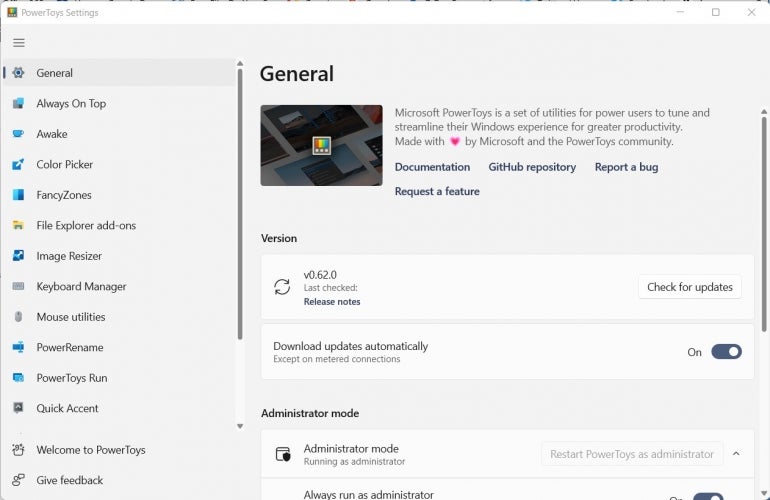 Image: Mark Kaelin/TechRepublic
Image: Mark Kaelin/TechRepublic
Windows PowerToys Version 0.70.0 is available on GitHub right now. Release v0.70.0 adds the Mouse Without Borders and Peek utilities to the toolset already available in PowerToys as well as makes some quality-of-life improvements and bug fixes.
Mouse Without Borders enables the ability to interact with other computers from the same keyboard and mouse and share clipboard and files between the machines. Peek provides a quick preview of files selected in File Explorer when users press a specified keyboard shortcut.
These PowerToys are currently available:
SEE: All of TechRepublic’s cheat sheets and smart person’s guides
What can Microsoft PowerToys do?Here is a list of available Microsoft PowerToys with a brief description of what each toy does.
FancyZonesFancyZones allows users to manage where and how each application window that is open on a Windows desktop will display.
SEE: Learn more about how to use and configure FancyZones.
For example, you could use FancyZones to set up a Windows 10 desktop where Outlook always displays on the right-hand side of the desktop, Twitter or other social media always displays on the left-hand side of the desktop, and Word or Excel always displays in the middle between the other two. There would be three distinct and perpetual zones displayed at all times (Figure B).
Figure B
 Image: Mark Kaelin/TechRepublic
Windows key Shortcut Guide
Image: Mark Kaelin/TechRepublic
Windows key Shortcut Guide
The Windows key Shortcut Guide displays all of the available keyboard shortcuts for the current Windows desktop (Figure C). This PowerToy is activated by holding the Windows key down for the length of time specified in the tool’s configuration settings. The default is 900ms.
SEE: Here’s how to use the Windows key Shortcut Guide.
With this feature, users don’t have to remember so many Windows key-related shortcut combinations.
Figure C
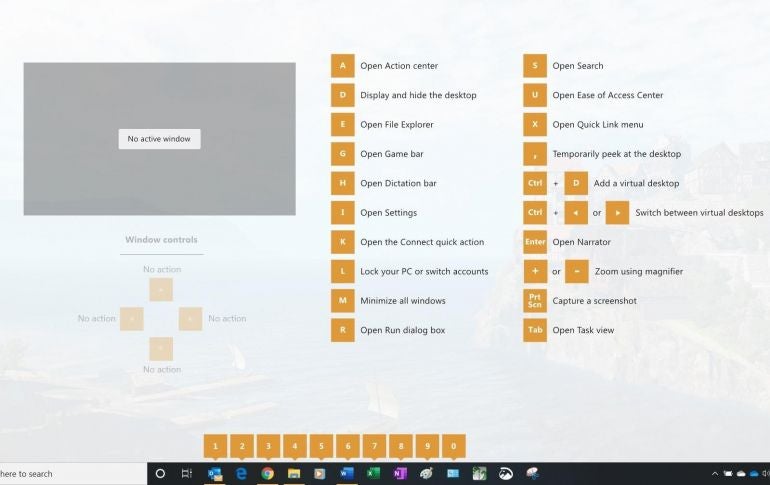 Image: Mark Kaelin/TechRepublic
PowerRename
Image: Mark Kaelin/TechRepublic
PowerRename
The PowerRename Windows PowerToy provides users with advanced tools for bulk renaming of files. The toy extends the Windows Shell Context Menu to add an entry for PowerRename to File Explorer (Figure D).
Figure D
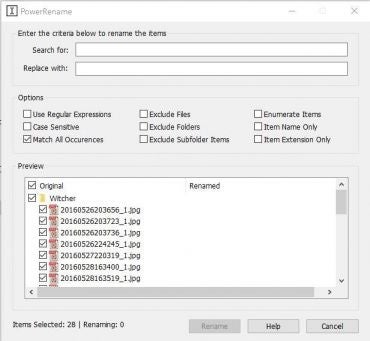 Image: Mark Kaelin/TechRepublic
Image: Mark Kaelin/TechRepublic
With PowerRename enabled, simple search and replace or more powerful regular expression matching are added to your toolset for the bulk renaming process. A preview area is displayed as you perform search and replace procedures, so you can see how file names will change before initiating the action.
Preview Pane add-ons for File ExplorerThis Windows PowerToy expands on the Preview Pane feature already available in the standard File Explorer application by adding additional file types. Preview Pane allows users to preview the contents of a file after clicking it in File Explorer without actually opening the file (Figure E).
Figure E
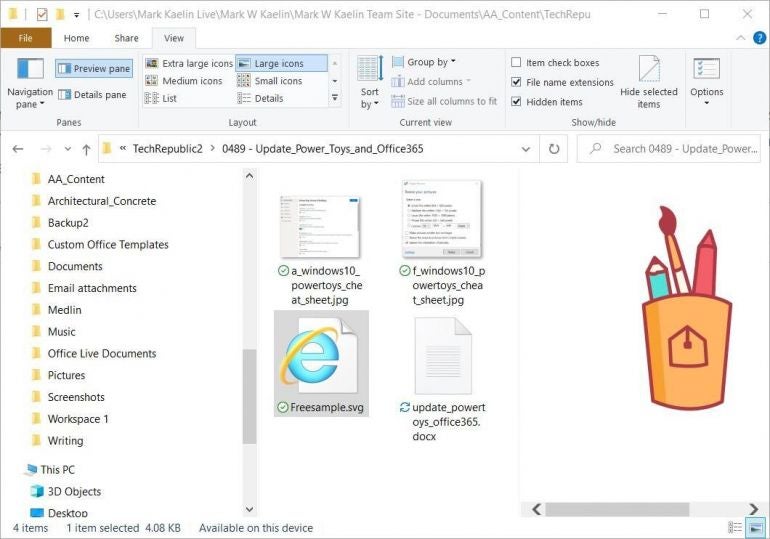 Image: Mark Kaelin/TechRepublic
Image: Mark Kaelin/TechRepublic
Version 0.16.0 adds preview support for Scalable Vector Graphics (.svg) and Markdown (.md) files. Subsequent PowerToys releases have added more file types including source code files and geometric code.
Image ResizerThe Image Resizer Windows PowerToy adds more functionality to File Explorer by allowing users to apply bulk image resizing. Users can select images in File Explorer and then select the new Resize Pictures item on the context menu, revealed with a right-click on any image (Figure F).
Figure F
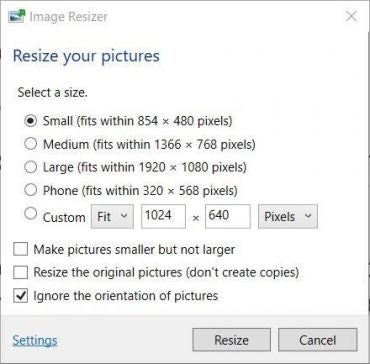 Image: Mark Kaelin/TechRepublic
Window Walker
Image: Mark Kaelin/TechRepublic
Window Walker
The Window Walker Windows PowerToy is designed to be an alternative to the standard Alt-Tab feature in Windows 10 and Windows 11. Users press the CTRL-Windows key combination instead of Alt-Tab to pull up a search box (Figure G). Users then enter keywords into the search box to narrow down the currently open apps and screens on their desktop.
Figure G
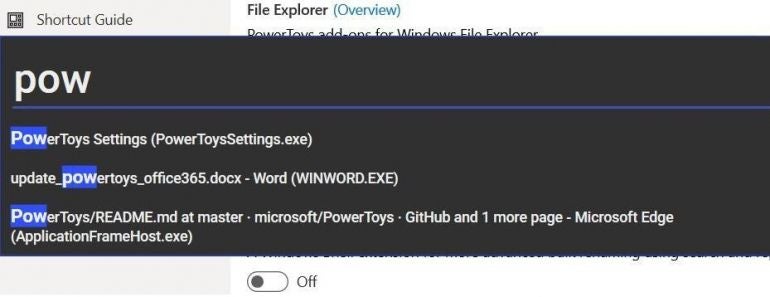 Image: Mark Kaelin/TechRepublic
PowerToys Run
Image: Mark Kaelin/TechRepublic
PowerToys Run
PowerToys Run acts as a quick launcher in Windows. It is another extension of the ALT-Tab concept and taps into the Windows file indexing system. To activate the tool, use the keyboard combination ALT-Space and start typing the name of your desired application (Figure H).
Figure H
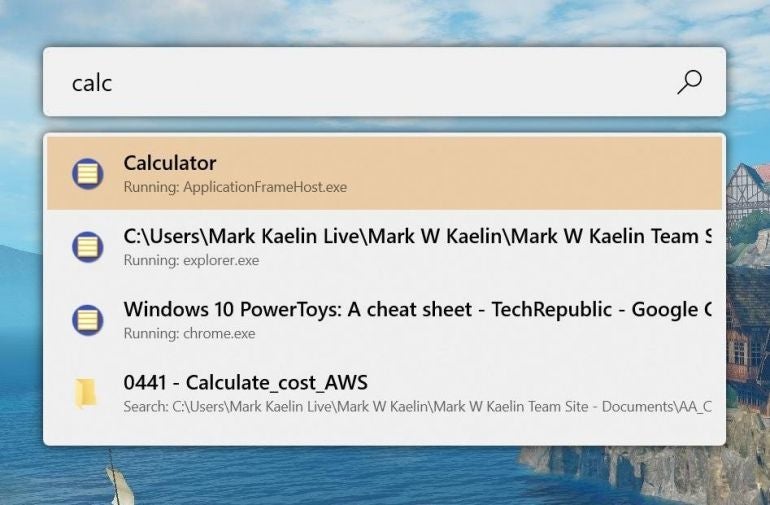 Image: Mark Kaelin/TechRepublic
Image: Mark Kaelin/TechRepublic
PowerToys Run will search the system and start listing possible applications based on your search phrase. When the application you desire appears, click or tap to run.
Keyboard ManagerThe Keyboard Manager application in Microsoft PowerToys is a simple keyboard remapper. Run the application from the PowerToys menu (Figure I) and either remap a single key on your keyboard or remap a shortcut keyboard combination. Whatever you remap will remain active as long as Keyboard Manager is enabled and PowerToys is running in the background.
Figure I
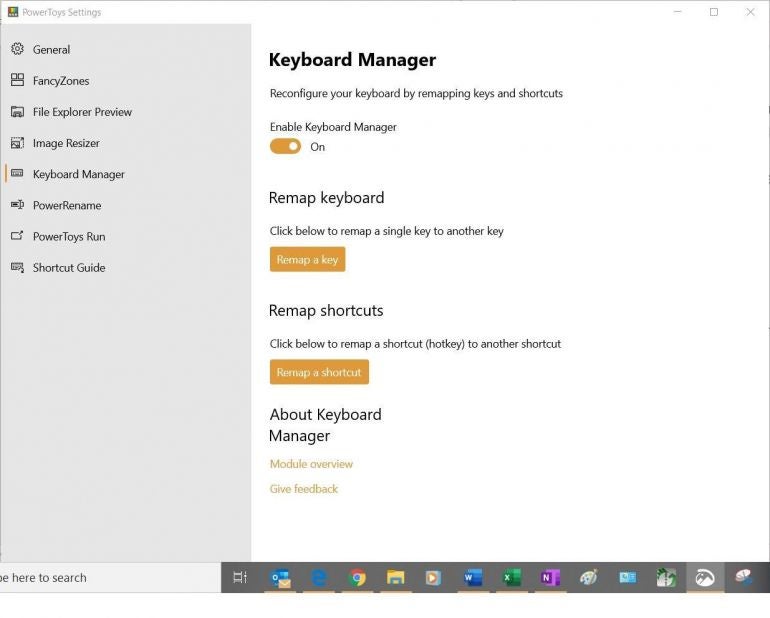 Image: Mark Kaelin/TechRepublic
Color Picker
Image: Mark Kaelin/TechRepublic
Color Picker
Color Picker was contributed to the Microsoft PowerToys project by Martin Chrzan. The utility allows you to identify any color on your screen by either its HEX or RGB code and then save that information to the Windows clipboard for later use (Figure J). It is a simple tool, but it can save time and prevent frustration for developers and content creators working on color design.
Figure J
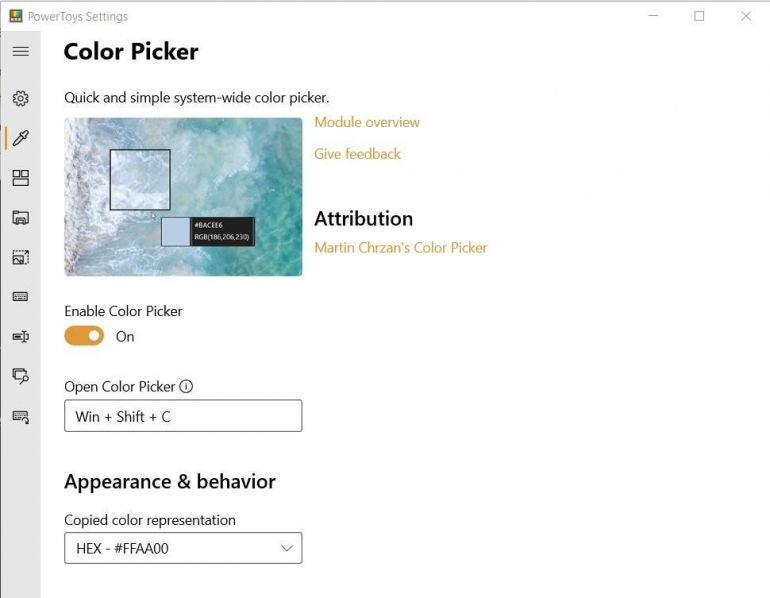 Image: Mark Kaelin/TechRepublic
Video Conference Mute
Image: Mark Kaelin/TechRepublic
Video Conference Mute
As a number of organizations shifted to remote work structures during the COVID-19 pandemic, many of us now rely on video teleconferencing for work and school interactions and collaboration. The Video Conference Mute tool in Microsoft PowerToys allows you to mute the audio and video on your PC with a single key combination (Figure K).
Figure K
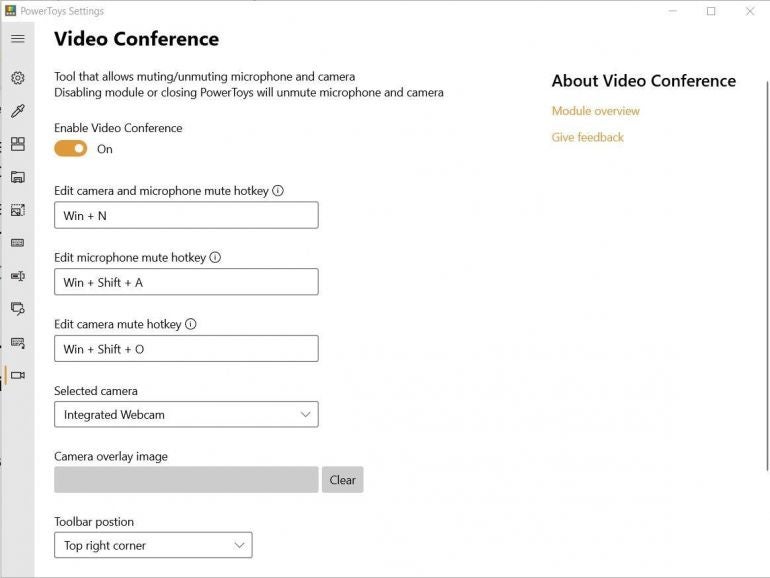 Image: Mark Kaelin/TechRepublic
Image: Mark Kaelin/TechRepublic
You may mute both audio and video at the same time or independently. The same key combination will toggle the audio and video back to the on position. The Video Conference Mute tool works regardless of what app you are using or what app is currently in the foreground.
AwakeThe Microsoft PowerToys tool Awake was contributed to the PowerToys project by the community with attribution given to Den Delimarsky. Awake allows users to keep their computer awake on-demand without having to manage its power settings (Figure L).
Figure L
 Image: Mark Kaelin/TechRepublic
Mouse utilities
Image: Mark Kaelin/TechRepublic
Mouse utilities
Mouse utilities was contributed to the Microsoft PowerToys project by Raymond Chen. Mouse utilities is a collection of features that enhance the mouse and cursor functionality on Windows systems.
SEE: Learn how to activate and use the Windows Mouse utilities.
With two consecutive presses of the Left CTRL key, Find My Mouse will locate your mouse cursor and highlight its current position with a halo (Figure M). Pressing the Esc key will dismiss the highlight. The Find My Mouse feature is useful for presentations on large displays when you want to draw the audience’s attention to a specific area of the screen.
Figure M
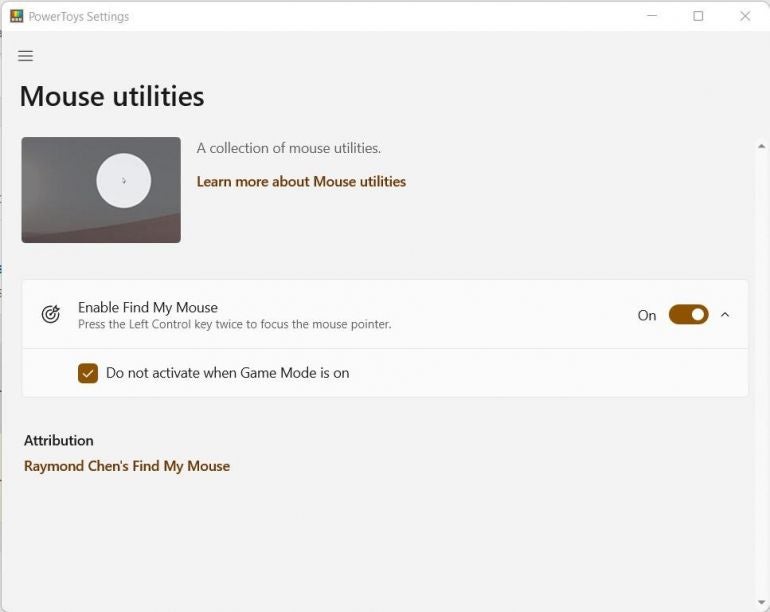 Image: Mark Kaelin/TechRepublic
Always on Top
Image: Mark Kaelin/TechRepublic
Always on Top
Always on Top allows users to designate the application window currently in focus as “always on top” with a keyboard shortcut toggle (Figure N).
Figure N
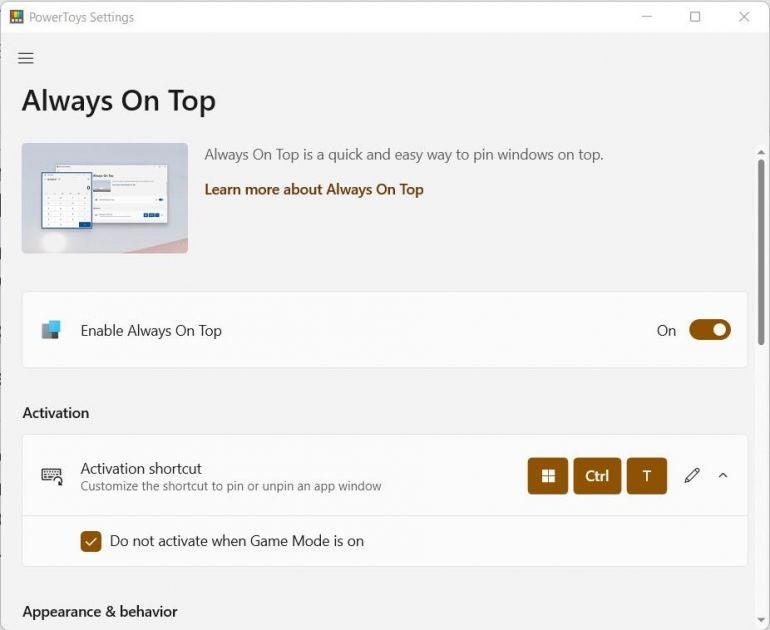 Image: Mark Kaelin/TechRepublic
Image: Mark Kaelin/TechRepublic
Regardless of what commands, mouse clicks or other inputs are made from that point on, the designated window will remain at the forefront, superseding any other open windows until Always on Top is toggled off. The default keyboard shortcut for the Always on Top toggle is Windows Key + CTRL + T.
Screen RulerThe Microsoft PowerToys utility, Screen Ruler is a quick and easy way to measure the pixels represented on your display screen (Figure O). The tool is perfect for determining the pixel size of a potential screen capture or for lining up objects in a document.
Figure O
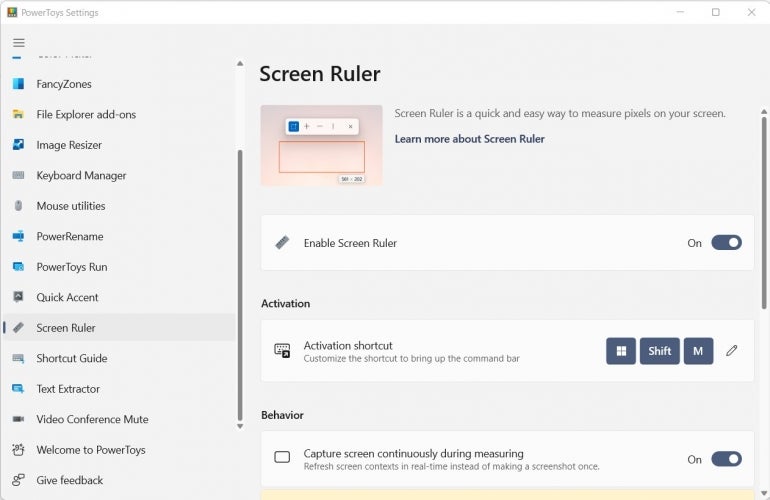 Image: Mark Kaelin/TechRepublic
Quick Accent
Image: Mark Kaelin/TechRepublic
Quick Accent
Quick Accent is an alternative way to type accented characters, which is useful for when a keyboard doesn’t support that specific accent with a quick key combo (Figure P). Use this utility to create accented characters, especially for writing in languages other than English.
Figure P
 Image: Mark Kaelin/TechRepublic
Text Extractor
Image: Mark Kaelin/TechRepublic
Text Extractor
The Microsoft PowerToys utility Text Extractor is a convenient way to copy text from anywhere on your screen (Figure Q). This code is based on Joe Finney’s Text Grab. Text Extractor uses optical character recognition to read the text on the screen, so it may require editing or proofreading.
Figure Q
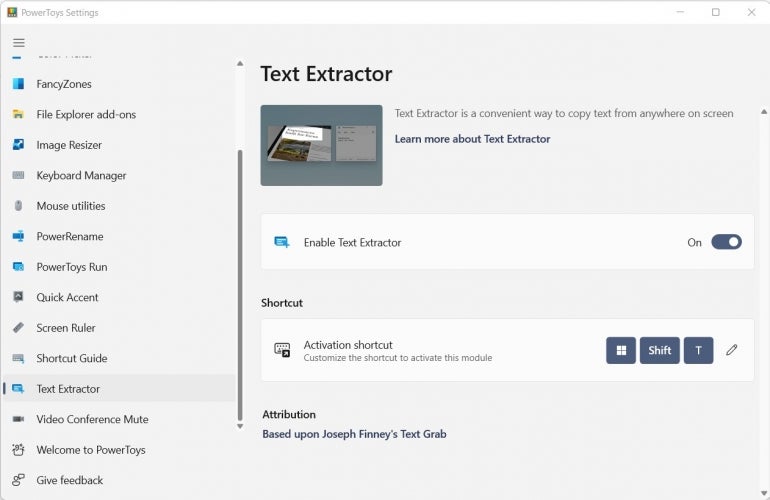 Image: Mark Kaelin/TechRepublic
File Locksmith
Image: Mark Kaelin/TechRepublic
File Locksmith
The Microsoft PowerToys utility File Locksmith is a Windows shell extension for checking what files are in use and by which processes (Figure R). After installing, right-click on one or more selected files in File Explorer, and then select “What’s using this file?” from the context menu.
Figure R
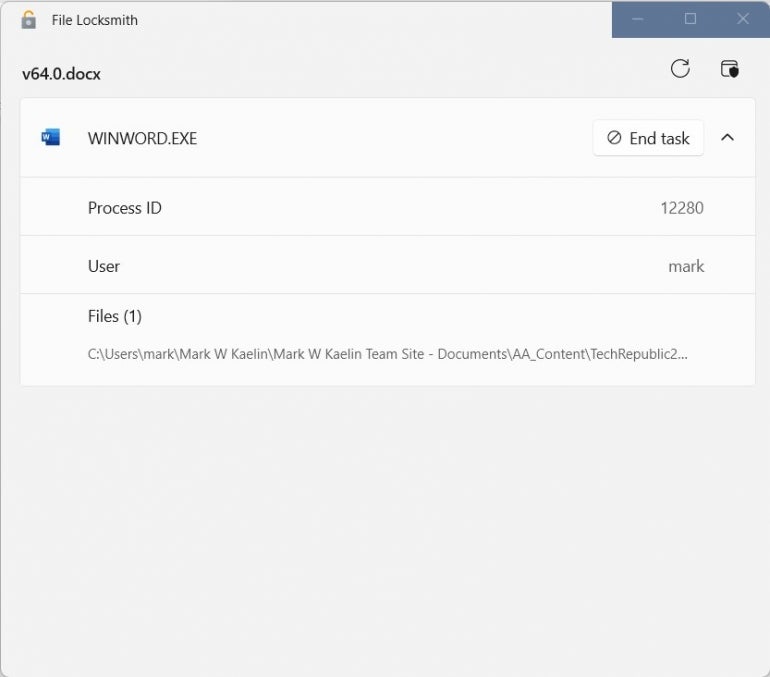 Image: Mark Kaelin/TechRepublic
Hosts File Editor
Image: Mark Kaelin/TechRepublic
Hosts File Editor
The Window PowerToys utility Hosts File Editor is a quick and simple utility for editing a local hosts file (Figure S). Note, the application will only work if a hosts file exists.
Figure S
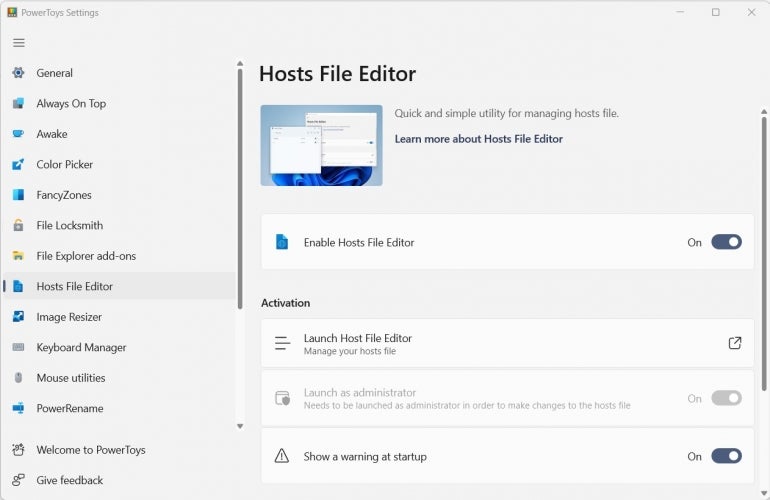 Image: Mark Kaelin/TechRepublic
Mouse Jump
Image: Mark Kaelin/TechRepublic
Mouse Jump
The Microsoft PowerToys utility Mouse Jump is a new feature for the existing set of mouse utilities (Figure T). Mouse Jump allows you to instantly move the mouse pointer great distances on the same screen and even jump from one screen to another, if you wish.
SEE: Learn more about the features that released with PowerToys 0.68.0.
Figure T
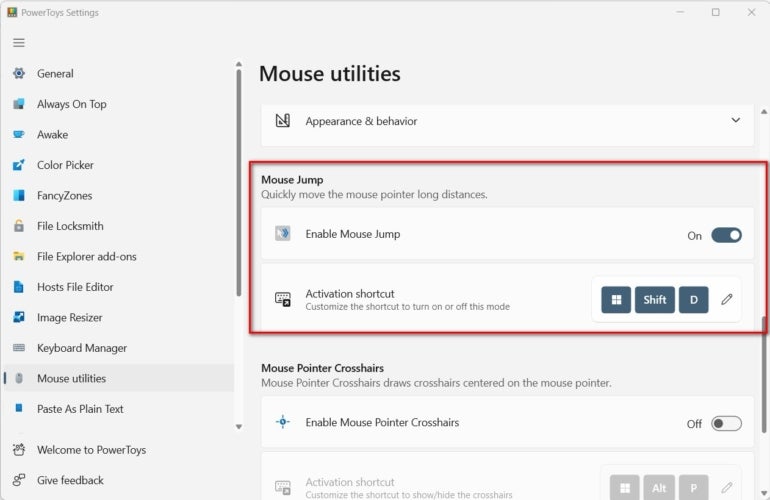 Image: Mark W. Kaelin/TechRepublic
Paste as Text
Image: Mark W. Kaelin/TechRepublic
Paste as Text
The Window PowerToys utility Paste as Text is a keyboard combination shortcut that allows users to paste formatted clipboard contents as plain unformatted text (Figure U). Using this tool will also replace the formatted text with plain text in the clipboard, so users can always paste as text.
Figure U
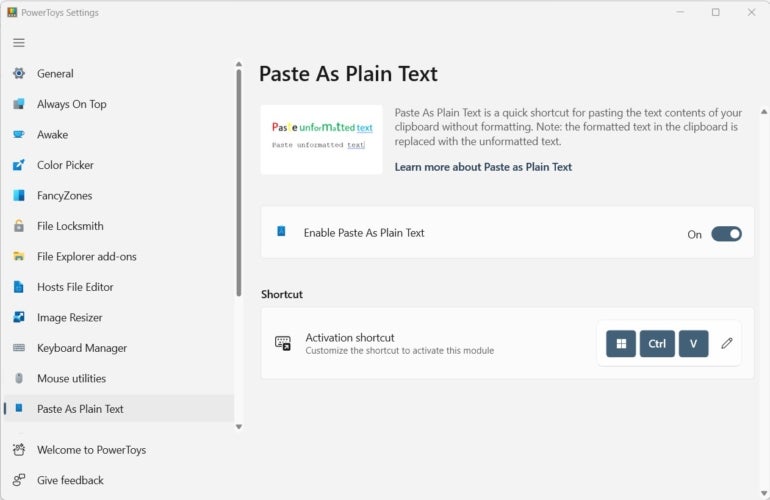 Image: Mark Kaelin/TechRepublic
Registry Preview
Image: Mark Kaelin/TechRepublic
Registry Preview
PowerToys Registry Preview, released in Version 0.69.0, is designed to simplify the process of visualizing and editing Windows Registry files (Figure V). The utility app also allows you to write registry changes directly to the Windows Registry file without using the standard Regedit app that comes built into the Windows operating system.
Figure V
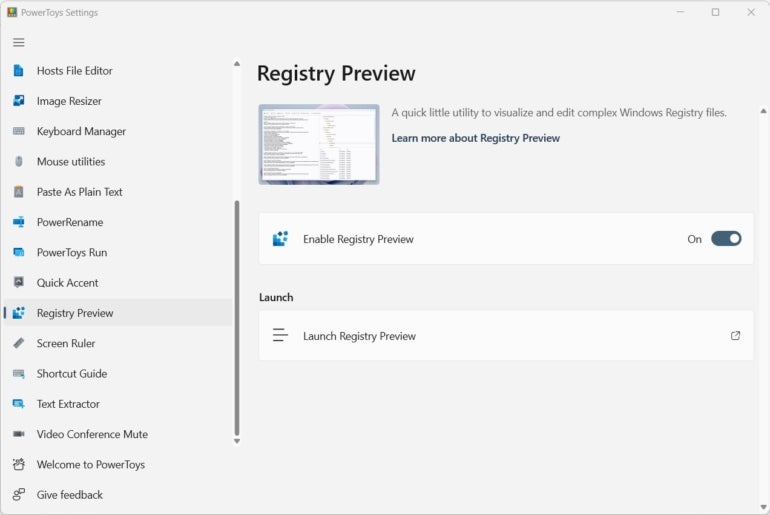 Image: Mark Kaelin/TechRepublic
Mouse Without Borders
Image: Mark Kaelin/TechRepublic
Mouse Without Borders
PowerToys Mouse Without Borders, released in Version 0.70.0, gives users the ability to interact with other computers using the same keyboard and mouse they are using for their current PC (Figure W). With Mouse Without Borders, users can also share clipboard and files between the machines. Control of the other computers is granted using an encryption key.
Figure W
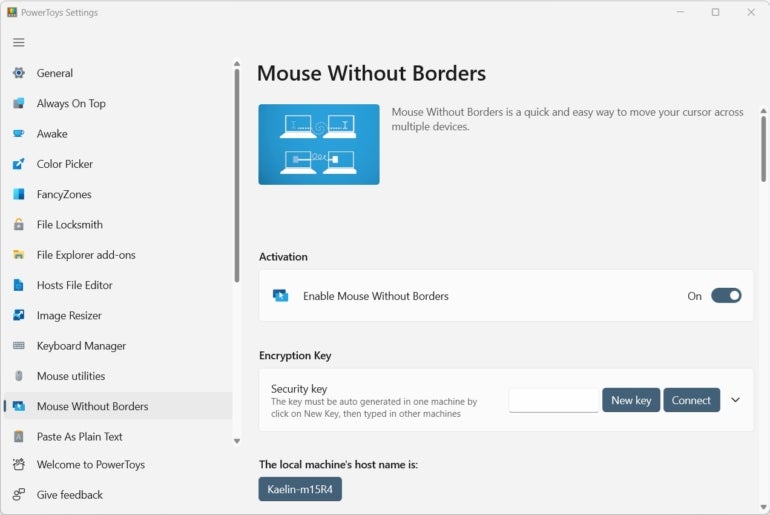 Image: Mark Kaelin/TechRepublic
Peek
Image: Mark Kaelin/TechRepublic
Peek
Peek, released in Version 0.70.0, allows users to see a quick preview of files they select in File Explorer when they press a specified keyboard shortcut (Figure X). The keyboard shortcut can be modified to a user’s preference.
Figure X
 Image: Mark Kaelin/TechRepublic
Are more Microsoft PowerToys coming soon?
Image: Mark Kaelin/TechRepublic
Are more Microsoft PowerToys coming soon?
New Microsoft PowerToys are periodically added to the Windows library to address new user expectations and requirements. As new PowerToys are released, this list of available tools will be updated to reflect that expansion.
Additional resources Why are Microsoft PowerToys important?Microsoft PowerToys provide tools and features that can make users of the Windows operating system more productive and, by extension, happier. Over the years, many users have come to depend on one or more of these PowerToys for their daily computer productivity. For many power users, PowerToys improve their quality of work and life.
SEE: Build a Microsoft 365 Services Usage Policy with this template from TechRepublic Premium.
Beyond making users more productive, PowerToys have also provided a glimpse into what features and tools could and should become an integral part of the Windows operating system in the future. Many of these once-separate tools have become just another part of the operating system during its next iteration.
Editor’s note: This article was updated to reflect the latest version of Microsoft PowerToys.